Lessico
Dorking
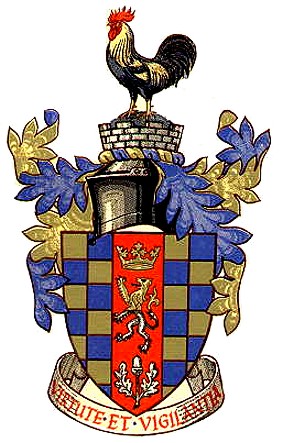
Arms of the former Dorking Urban District Council
Arms: Chequy Or and Azure a Pale Gules thereon a Lion rampant per fesse of the first and Argent between in chief a Ducal Coronet Gold and in base a Sprig of Oak fructed also Argent.
Crest: On a Wreath of the Colours within a Mural Crown Argent a Mount Vert standing thereon a Dorking Cock proper.
Motto 'Virtute et vigilantia' - By courage and vigilance.
Granted 24th August 1954.
The arms represent the passing of the Manor of Dorking from the Warrennes to the Howards. The gold and blue chequers are from the arms of the Warrennes, ancient Earls of Surrey. The first Earl recieved the the Manor with his bride, the daughter of William I. The Manor then passed to the FitzAlans of Arundel, who bore a gold lion on red, and then to the Morbays, who bore a white lion on red. These two lions are combined on the red pale, which also represents the old Roman Road. The ducal coronet refers to the Dukes of Norfolk, who later came into possession of the Manor. The white acorn is from the arms of the Surrey County Council, and is part of the heraldry of the Dukes of Norfolk, who are also Earls of Surrey.
The mural crown is a familiar symbol of local government and in this case is coloured to indicate the many buildings hereabouts made of Dorking lime. The mound represents the local heights, especially Box Hill and upon this is a cock of the distinctive five-toed Dorking breed. The motto is a quotation from Cicero.
www.civicheraldry.co.uk
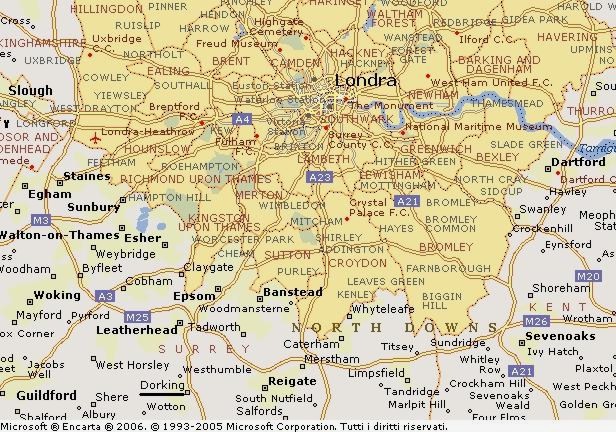
Dorking
Population
17,000
District Mole Valley
Shire county Surrey
Region South East
Constituent country England
Sovereign state United Kingdom
UK Parliament Mole Valley
European Parliament South East England
Coordinates: 51°14'02"N0°19'55"W
Surrey
Dorking is a market town at the foot of the North Downs approximately 25 miles south of London, in Surrey, England.
History and development
Dorking began life as a small staging post on Stane Street, the Roman Road which linked London to Chichester on the English Channel. Dorking appears in Domesday Book of 1086 as Dorchinges. It was held by William the Conqueror. Its Domesday assets were: 1 church, 3 mills worth 15s 4d, 16 ploughs, 3 acres of meadow, woodland and herbage worth 88 hogs. It rendered £18. In the 11th Century, Dorking was recorded in the Domesday Book as the Manor of Dorchinges.
Subsequent Lords of the Manor were to include the Dukes of Norfolk — who lived in Dorking until they moved to Arundel: one of whom is buried in Dorking churchyard. In the Medieval period, Dorking was a prosperous agricultural and market town, benefitting from its position on the junction of a number of important roads and tracks.
In 1750, the construction of a Turnpike Road made Dorking a staging post on the route to Brighton and the coast. The Bull’s Head in South Street had a famous coachman, William Broad, whose portrait hangs in Dorking Museum in West Street. The inn which now dominates the centre of Dorking, the White Horse, was developed in the 18th century; previous buildings on this site having belonged to the Knights Templar and later the Knights of St John.
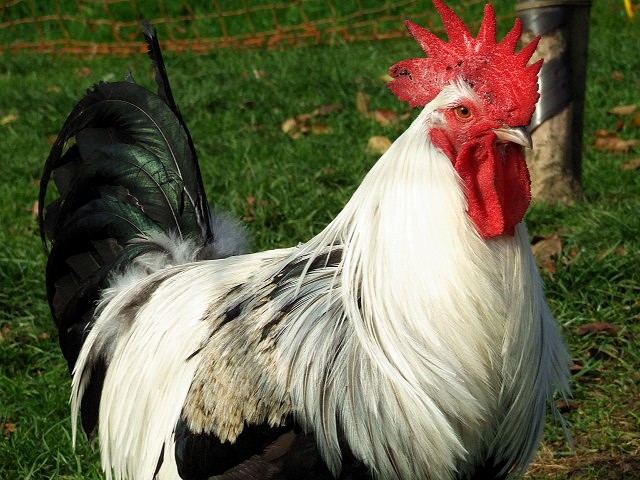
Dorking held a big wheat and cattle market in the High Street. The poultry market was held in the corner of South Street and round Butter Hill. Here the famous Dorking fowl were sold. This breed which has 5 claws instead of the normal four, was a favourite for 19th century tables, including Queen Victoria's.
Dorking lost its stage coaches when the railways arrived, but now attracted wealthy residents who built large houses in and around Dorking, such as Denbies (now a winery) and Pippbrook House (now the library, with Council Offices in the grounds). Surrounding land and beauty spots such as Cotmandene and Box Hill were donated by landowners for public use and this, together with later planning controls, has enabled Dorking to remain one of the most pleasant towns within convenient reach of London, having escaped much of the modern development witnessed by its neighbours. [Overell, B. 2005, Dorking Local History Group].
A game resembling rugby was once played here. The two sides were unlimited in number, representing the east and west of the town. The goals were the 2 bridges on the Pipp Brooke. The Town crier kicked off the ball at 2 o' clock and stopped play at 6 o'clock. The game was started at the Church gates and was "rioted" up and down the High Street. It was ceased in 1897 after complaints by tradesmen and it was officially stopped under section 72 of the Highway Act 1835.
Topography, natural history and local landscape
Just north of the town the River Mole cuts a steep-sided valley through the North Downs. On the left bank is Denbies Vineyard, the largest vineyard in the UK. On the right bank is Box Hill, owned by the National Trust and Britain's first Country Park. The hill has been designated a Site of Special Scientific Interest, because of the large number of rare orchids which grow there in the summer.
Further north is Norbury Park which contains the Druids Grove — a forest of ancient yew trees, some of which are more than 1000 years old.
To the south west of the town is Leith Hill — also owned by the National Trust, the highest point in the south of England, reaching 1,000ft at the tower on top of the hill. Along with the adjacent hills of Holmbury Hill and Pitch Hill, as well as the nearby escarpment of the North Downs from Box Hill to Newlands Corner, the area is known as 'The Surrey Hills'.
A new species of fish-eating dinosaur — Baryonyx walkeri was discovered in clay pits just south of Dorking. The creature had a long curved claw on each hand and remains of its last meal were discovered fossilised in its ribcage. The skeleton can be seen at the Natural History Museum in London.
Modern Dorking
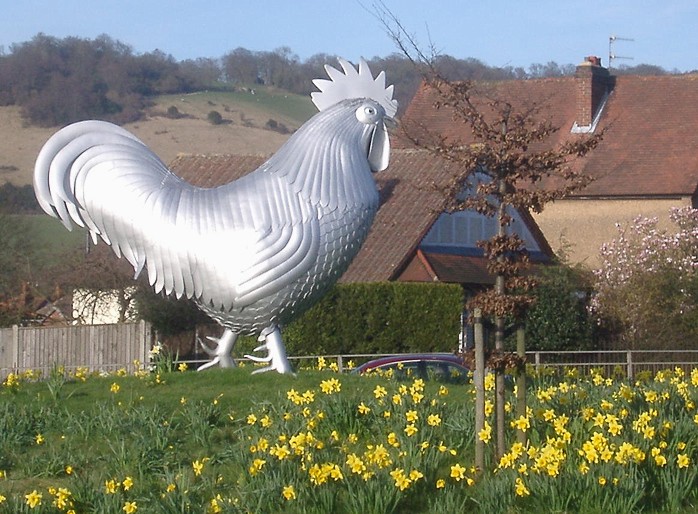
The
giant statue of a Dorking Cockerel
located in the middle Deepdene's roundabout
at the Eastern end of this Surrey town.
The statue is 15 foot high - 4.57 m.
Photo (c) 2007 Howard Fisher
The
evolution of the Dorking has been kind to the town centre. Much of the
original character survives, whilst accommodating businesses that serve the
needs of the 21st century. The town is known worldwide for its antique dealers.
The town's three main trading streets of High Street, West Street and South
Street are complemented by a small open-air shopping centre, St Martin's Walk
which is adjacent to the town's main car park and easily accessed from the
High Street.
In the late 1990s Dorking Halls was given a huge refit, to make it a cinema
and theatre complex. In 2003 a new modern leisure centre and swimming pool
were added to the Dorking Halls Complex. There is now a giant statue of a
Dorking Cockerel located on the Deepdene roundabout.
Local government
Dorking is the administrative centre of Mole Valley District Council. It had been an urban district from 1894 to 1974. It is situated in the Mole Valley parliamentary constituency, having formerly been the epicentre of its eponymous predecessor, the Dorking constituency.
Four toed chicken of Dorking's Judo Club
British Civic Heraldry
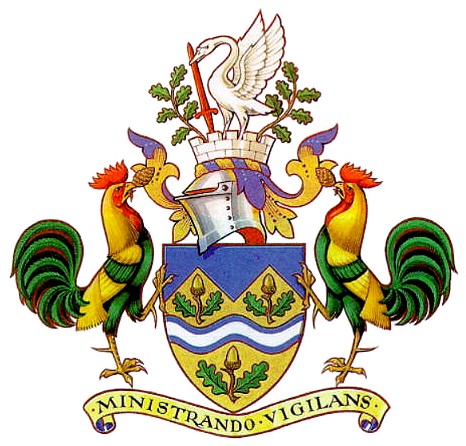
Mole Valley
Additions: 1974 Dorking, Dorking and Horley (partly), Leatherhead
The arms were granted on June 3, 1975.
The shield is a heraldic representation of the area. Across the gold field runs a blue and white wave representing the River Mole, with the Dorking urban and rural areas on one side and the Leatherhead area on the other. The acorns are taken from the arms of the three former authorities and that of the Surrey County Council.
Behind the Dorking acorns are two stylised hills representing Box Hill and Leith Hill, two notable geographical features of the district, with a blue sky above. The hill figuration also suggests the letter M with a V in the middle.
The crest features a swan, prominent in the former Leatherhead arms, which alludes to the old Swan Inn of coaching days and to the river and other local waters. The swan holds in its beak a red sword pointing upwards, referring to the association with the City of London through the City Freeman's School and to the connection between the former arms and the 1939-45 war, the Leatherhead arms being the first in heraldry to commemorate the unity of purpose of the Civil Defence Services.
Flanking the swan are two branches of oak leaves linking with the oak in the shield, and are a direct reference to the former Leatherhead crest and the County shield.
The supporters are two cocks of the distinctive five-toed Dorking breed taken from the Dorking crest and characteristic of the surrounding rural area. Each cock holds in its beak a pine cone from the former Dorking Rural District crest, the cones referring to the Weald/Leith Hill wooded area of the district.
The motto, 'Ministrando Vigilans' ('Vigilant in our serving') which gives the initials MV is a derivation of those of the former Dorking & Leatherhead Councils, 'Virtute et Vigilantia' ('By Courage and Vigilance') and 'Service links all'.
www.ngw.nl